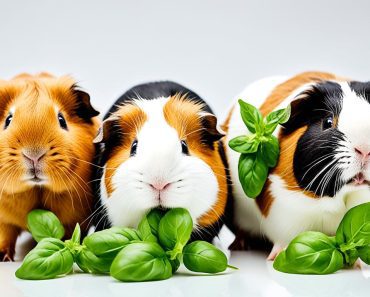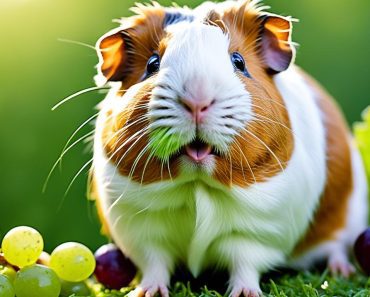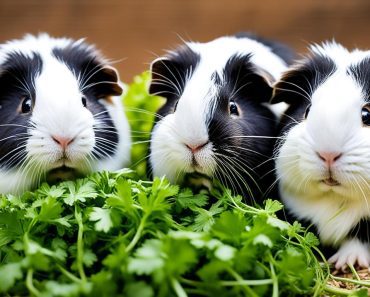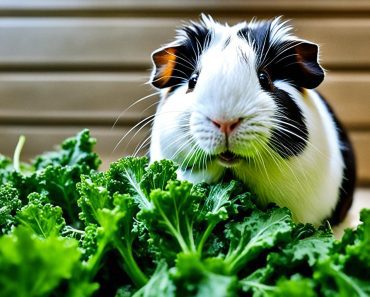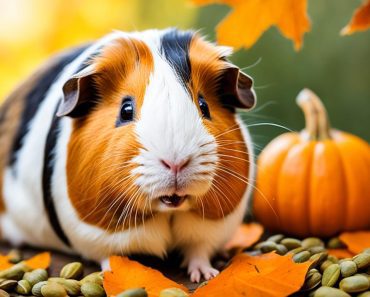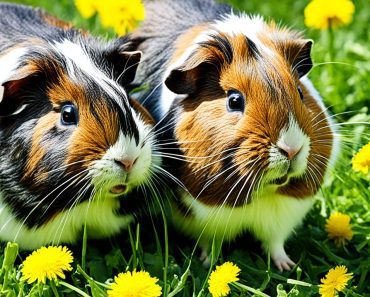I’m excited to share some valuable insights with you about guinea pigs and green beans. Many pet owners wonder whether it’s safe to feed green beans to their furry friends. As a guinea pig enthusiast, I know the importance of a balanced diet for these adorable animals. Let’s dive into the topic and explore the benefits and risks of feeding green beans to guinea pigs.
Green beans are packed with essential nutrients that can enhance a guinea pig’s overall well-being. They contain vitamins A, C, and K, fiber, iron, and calcium, making them a healthy addition to their diet. Moreover, green beans are low in calories and sugar, which is perfect for guinea pigs watching their weight or sugar intake.
However, it’s crucial to remember that moderation is key. Feeding excessive amounts of green beans can lead to gas and bloating in guinea pigs. It’s vital to introduce green beans gradually and monitor their digestion. Additionally, it’s essential to wash green beans thoroughly to remove any potential pesticide or herbicide residue.
To learn more about the guinea pig’s diet and what other fruits and vegetables they can eat, keep reading! But first, let’s take a look at some key takeaways from this section:
Can Guinea Pigs Eat Green Beans? Yes, as an occasional treat.
- Green beans are safe for guinea pigs and provide essential nutrients.
- They are low in calories and sugar, making them a healthy snack option.
- Introduce green beans gradually to avoid gas and bloating.
- Wash green beans thoroughly to minimize pesticide exposure.
- Consult a veterinarian or an experienced guinea pig owner for advice on a balanced diet.
The Importance of a Proper Guinea Pig Diet
As a guinea pig owner, it’s crucial to understand the importance of providing your furry friend with a proper diet. Guinea pigs are herbivores, which means their diet should primarily consist of grass hay, pellets, fresh vegetables, and fruits. A well-balanced diet ensures that your guinea pig receives all the necessary nutrients for optimal health and wellbeing.
Hay should comprise around 80% of your guinea pig’s daily diet. It plays a vital role in their digestive health, as well as providing them with necessary fiber for proper gut function. High-quality grass hay, such as Timothy or Orchard grass, is the best option for guinea pigs.
In addition to hay, guinea pigs should also be given a small portion of pellets each day. Look for pellets that are specifically formulated for guinea pigs to ensure they are receiving the right balance of nutrients. However, it’s important to remember that pellets should not be the main component of their diet.
Fresh vegetables are essential for guinea pigs, as they provide important vitamins and minerals. Dark leafy greens, such as spinach, kale, and romaine lettuce, are excellent choices. Other safe vegetables include bell peppers, cucumbers, and carrots. It’s important to introduce new vegetables gradually and monitor your guinea pig’s digestion to ensure they tolerate them well.
Fruits can be given to guinea pigs, but in moderation. While fruits are a tasty treat for them, they are high in sugar and should be fed sparingly. Some safe fruits for guinea pigs include apples, strawberries, and melons.
Remember: Green beans can be included in your guinea pig’s diet as part of their fresh vegetable intake. They provide additional nutrients and variety. Just make sure to introduce green beans gradually and monitor their digestion.
Providing your guinea pig with a proper diet not only helps them maintain a healthy weight, but it also supports their immune system and overall wellbeing. It’s essential to consult with a veterinarian or an experienced guinea pig owner to ensure you are meeting all of your pet’s nutritional needs.
The Importance of Vitamin C
Guinea pigs cannot produce their own vitamin C, so it’s crucial to provide them with this essential nutrient in their diet. Lack of vitamin C can lead to a condition called scurvy, which can cause weakness, joint pain, and even death in severe cases.
To ensure your guinea pig receives enough vitamin C, incorporate foods rich in this vitamin into their diet. Some good sources include bell peppers, kale, tomatoes, and of course, green beans.
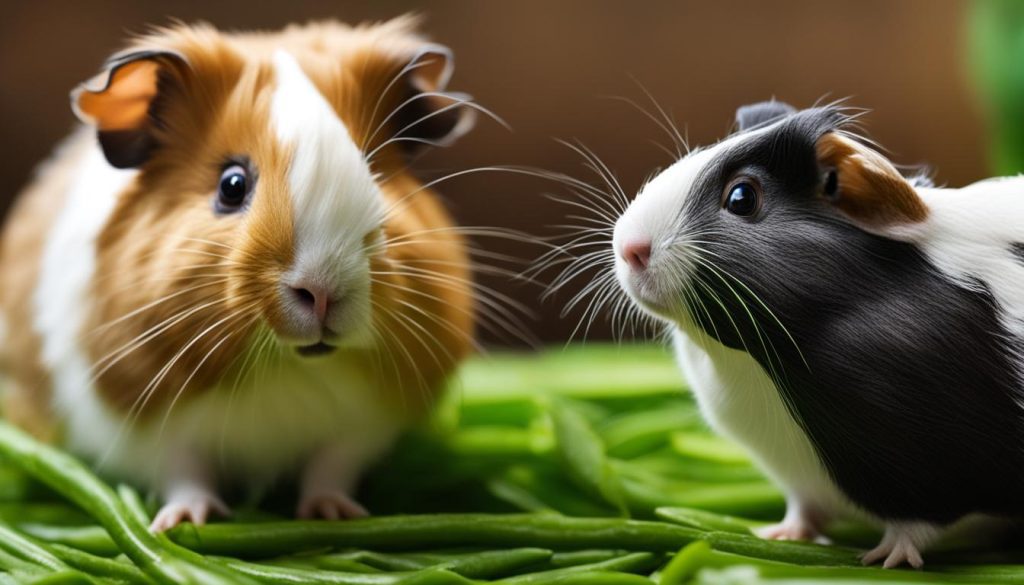
| Safe Vegetables for Guinea Pigs | Unsafe Vegetables for Guinea Pigs |
|---|---|
|
|
Benefits of Feeding Raw Green Beans to Guinea Pigs
Raw green beans offer several benefits for guinea pigs. They are packed with essential nutrients, including vitamins A, C, and K, as well as fiber, iron, and calcium. Green beans are low in calories and sugar, making them a suitable snack for guinea pigs watching their weight or sugar intake. The high water content in green beans can contribute to guinea pigs’ hydration. The crunchy texture of green beans also promotes dental health by wearing down their continuously growing teeth. However, it’s important to introduce green beans slowly to avoid gas and bloating, and to wash them thoroughly to minimize pesticide exposure.
Incorporating raw green beans into your guinea pig’s diet can provide them with a refreshing and nutritious treat. The combination of vitamins, minerals, and fiber offered by green beans supports their overall well-being. These vegetable treats can help guinea pigs maintain their weight and sugar levels while promoting their hydration through the added water content.
Feeding raw green beans to guinea pigs can also keep their teeth healthy. Guinea pigs have continuously growing teeth, and the crunchiness of green beans can help wear down their teeth naturally. This helps prevent dental issues that can arise from overgrown teeth.
When introducing green beans to your guinea pig’s diet, it’s important to start with small amounts and observe their reaction. Some guinea pigs may be more sensitive to new foods, and gradual introduction can help prevent any digestive discomfort. It’s recommended to wash the green beans thoroughly before feeding them to your guinea pig, as this can help remove any residual pesticides or herbicides that may be present.
- Rich in essential nutrients
- Low in calories and sugar
- Contributes to hydration
- Promotes dental health
By including raw green beans in your guinea pig’s diet, you can provide them with a variety of nutrients and enrichment while ensuring their overall health and well-being.
| Nutrient | Amount per 100g of Raw Green Beans |
|---|---|
| Vitamin A | 15% of the Recommended Daily Intake (RDI) |
| Vitamin C | 22% of the RDI |
| Vitamin K | 26% of the RDI |
| Fiber | 7% of the RDI |
| Iron | 3% of the RDI |
| Calcium | 3% of the RDI |
Risks of Feeding Green Beans to Guinea Pigs
While green beans can be a healthy addition to a guinea pig’s diet, there are some risks to be aware of. Feeding green beans in excess can cause gas and bloating in guinea pigs. It’s important to introduce green beans slowly and in small quantities to avoid digestive discomfort.
“Feeding green beans in moderation ensures that guinea pigs can enjoy their nutritional benefits without any negative consequences,” explains Dr. Emily Johnson, a guinea pig specialist.
Green beans, like other fruits and vegetables, may have been exposed to pesticides or herbicides during cultivation. To minimize any potential risks, it is crucial to wash green beans thoroughly before feeding them to guinea pigs. This will help remove any residue that could harm their sensitive digestive systems.
“By washing green beans properly, we can significantly reduce the chances of guinea pigs being exposed to harmful chemicals,” adds Dr. Johnson.
Additionally, while rare, some guinea pigs may have allergies or digestive sensitivities to green beans. It’s essential to observe your guinea pig closely after introducing green beans and look out for any signs of discomfort or allergic reactions. If you notice any issues, consult a veterinarian for guidance.
Guinea Pig Owner’s Tip:
“When introducing green beans to my guinea pigs, I always start with a small piece as a treat and gradually increase the quantity over time. This way, I can monitor their digestion and prevent any potential issues,” shares Maria Rodriguez, a seasoned guinea pig owner.
Remember, every guinea pig is unique, and it’s important to pay close attention to their individual responses to different foods. If you have any doubts or concerns, consult with a veterinarian who is knowledgeable about guinea pig care.
| Common Risks of Feeding Green Beans to Guinea Pigs | Preventive Measures |
|---|---|
| Gas and bloating | Introduce green beans slowly and in small quantities |
| Pesticide or herbicide exposure | Thoroughly wash green beans before feeding them |
| Allergies or digestive sensitivities | Observe closely for any signs of discomfort or allergic reactions |
By being aware of the potential risks and taking appropriate precautions, you can safely incorporate green beans into your guinea pig’s diet and provide them with a varied and nutritious menu.
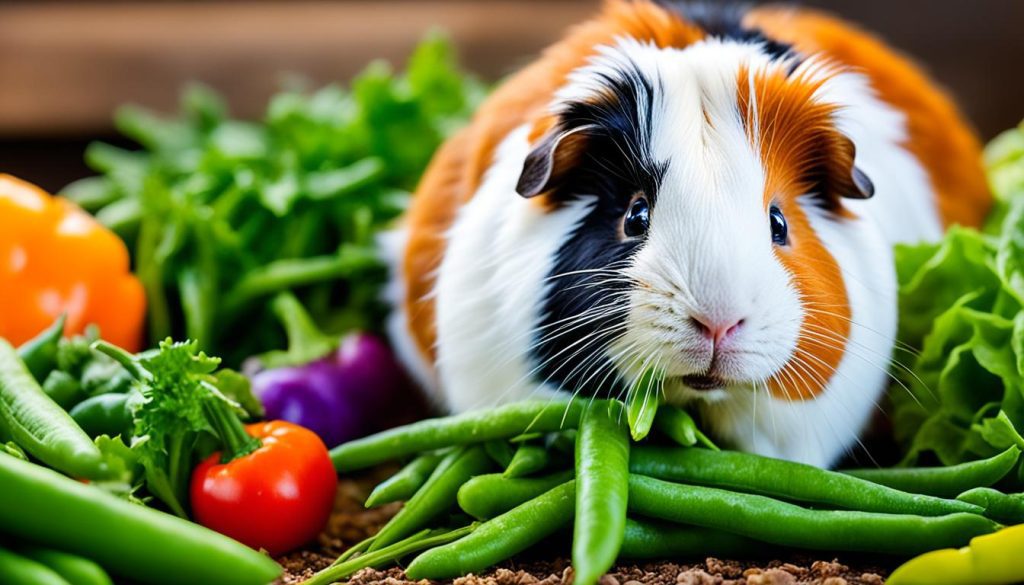
What are Other Fruits and Vegetables That Guinea Pigs Can Eat?
In addition to green beans, there are several other fruits and vegetables that guinea pigs can safely enjoy as part of their diet. These foods not only provide essential nutrients but also add variety to their meals. Here are some examples:
- Blueberries: Rich in antioxidants, blueberries are a delicious and healthy treat for guinea pigs. They are a great source of vitamin C and fiber.
- Watermelon: Juicy and refreshing, watermelon can be a favorite summer snack for guinea pigs. It’s high in water content and contains essential vitamins and minerals.
- Pumpkin: A seasonal treat, pumpkin is rich in fiber and nutrients like vitamin A. It can be served cooked or raw, but make sure to remove the seeds and skin.
- Zucchini: Zucchini is a low-calorie vegetable that provides a good amount of vitamin C and fiber. It can be served raw or cooked, but ensure it is sliced into small, manageable pieces.
- Carrots: Carrots are a classic vegetable that guinea pigs love. They are packed with vitamin A and provide a satisfying crunch. Remember to cut them into bite-sized pieces.
When introducing new fruits and vegetables to your guinea pig’s diet, it’s important to do so gradually and in moderation. This helps prevent digestive upset and allows their bodies to adjust to the new foods. Additionally, always ensure that the produce you offer is fresh, clean, and free from pesticides or other harmful substances.
Conclusion
After considering the facts, it is clear that green beans can be a safe and nutritious choice for guinea pigs. These vibrant veggies offer a range of essential nutrients, such as vitamins A, C, and K, fiber, iron, and calcium. They also promote hydration and contribute to dental health, thanks to their high water content and crunchy texture.
However, it’s crucial to introduce green beans gradually and in moderation to avoid any potential digestive issues. Gas and bloating can occur if green beans are overfed, so it’s best to start with small quantities. Additionally, washing green beans thoroughly is important to remove any traces of pesticides or herbicides that may harm your guinea pig’s health.
Remember that while green beans can be a tasty addition to your guinea pig’s diet, they should not replace the main sources of nutrition. A balanced and varied diet that includes hay, pellets, and other vegetables is essential for their overall well-being. If you’re unsure about how to incorporate green beans into your guinea pig’s diet, it’s always wise to consult with a veterinarian or an experienced guinea pig owner.

